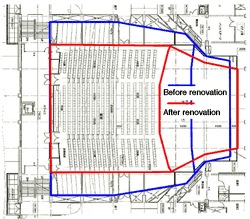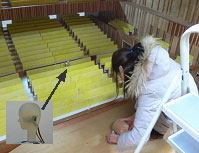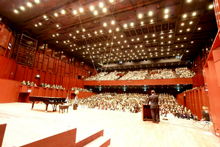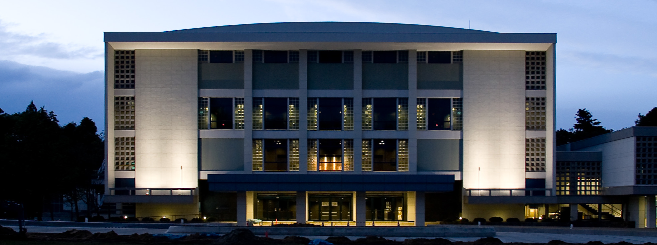Acoustic Design
Professor Yȏiti SUZUKI
Advanced Acoustic Information Systems Laboratory
Research Institute for Electrical Communication
1. Acoustic Design of the Former Kawauchi Memorial Auditorium
The late Professor Emeritus Tadamoto Nimura*, in cooperation with late Ken'ti KIDO and Toshio SONE (all three are Professors Emeriti of the university), was in charge of the original acoustic design. Professor Nimura attained rich reverberation (reverberation time of 2.0 seconds when vacant), and designed an excellent acoustic facility equipped with the most advanced electro-acoustic devices available at the time. Even by present standards, it offered an outstanding acoustic quality as a multipurpose hall. However, when compared with more recent halls, we could not help feeling that the acoustic design was somewhat outdated and could be improved.
(* He was a professor of the Department of Electrical Engineering in the School of Engineering, Tohoku University. As an Associate Professor of this department, he worked under Prof. Heiichi Nukiyama, who in turn had studied abroad at MIT under the supervision of Prof. Arthur Edwin Kennelly, a disciple of Thomas Edison.)
2. Basic Acoustic Design Concept
Taking the rare opportunity to completely renovate a hall of this scale, starting from the structure's shape, the goal of the acoustic design was to simultaneously achieve the acoustics of a first-class concert hall and a satisfactory sound space for lectures. Generally speaking, this is a highly challenging task.
3. Central Points of the Acoustic Design
- The shoebox shape (a common design used in the best concert halls in the world, such as the Amsterdam Concertgebouw) was employed to realize first-class concert hall acoustics. The stage was also drastically expanded in order to accommodate large-scale orchestras and choirs.
- The early reflection of sound from the side walls is critical in creating a high-quality acoustic space. For this reason, the width of the first floor was narrowed to the ideal measure for a shoebox hall: approximately 20 m. In addition, asymmetric diffusers were installed on the left and right walls to ensure the appropriate diffusion of sound within the hall.
- It was necessary to increase the volumeper seat in order to achieve good acoustics, so the number of seats was reduced from 1900 to 1230. This led to an ample volume of 9.0 m³ per seat.
- In order to produce acoustics appropriate both for wide-ranging musical performances and for international conferences, the target value for the reverberation time (the time it takes for the energy of sound to decay to one millionth of its initial value) was set at 1.8 seconds (at full-house for 500 Hz sounds)—the optimal value given the capacity of the hall.
- The type and placement, as well as the directivity, of the loudspeakers were carefully considered in order to produce clear sounds.
- The noise level, which is closely related to the lingering perception of room reverberation, was set in accordance to the extremely high standard, i.e. low noise level, of NC15.
4. Acoustic Design Process

Figure 1: Before and after hall renovations. Comparison of the floor plans.

Figure 2. A scene of 1:10 scale model test. On the lower left is the precisely crafted 1:10 dummy head developed for this project.

Figure 3. A scene of the measure- ment with 1230 volunteers.
Renovation planning: The changes to the shape of the hall during its renovation are shown in Figure 1. Although we had to face tougher legal and structural restrictions than those regulating the construction of new buildings, the tremendous cooperation of the design team allowed us to meet most of the requests from the acoustics team. Considering that acoustic design is typically regarded as part of the architectural outline, we are deeply thankful that the acoustic design was given so much consideration in this project.
Verification of the hall's acoustic properties before its completion through the auralization of a 1:10 scale model: A study of new auralization technologies was carried out under the President's discretionary budget in order to verify the acoustics of the hall before its completion. The study combined the results from a 1:10 scale model test (Fig. 2, showing best auralization performance at low frequencies) and a computer simulation (producing best results at high frequencies) to succeed in developing the first high-precision auralization system covering the entire audible frequency range from 20 Hz to 20 kHz. We call this method Hybrid Auralization Technology (HAT).
HAT was used to predict, with high accuracy, the results of the hall's renovation before its completion in October 2008. This allowed us to conclude that the acoustics of the renovated hall would reach the highest standard that could be expected.
Verification of the hall's acoustic properties after its completion through an in-situ measurement: Humans act as good sound absorber. Although this is, of course, well considered when designing music halls, the real acoustics can be known only by measurement after its completion with full of audience. Actually this is very difficult to fill halls with audience and is rarely done. This hall did it. On 10 December 2008, 1230 volunteers filled all the seats of the hall to measure a few acoustic characteristics, including the reverberation time. Volunteers also enjoyed a concert held after the measurement.
5. Realized Acoustic Properties
Reverberation time, the most widely used index for a hall's acoustics, was 1.8 seconds, as designed. Furthermore, binaural cross-correlation, a metric for the sense of sound extension, was found to reach extremely good values between 0.42 and 0.44. As for noise levels, the hall complies with the high standard of NC15.
Measurements of the Rapid Speech Transmission Index (RASTI), an index of speech intelligibility, showed good performance at all measurement points. Values for this index surpassed 0.45, indicating good speech intelligibility.


